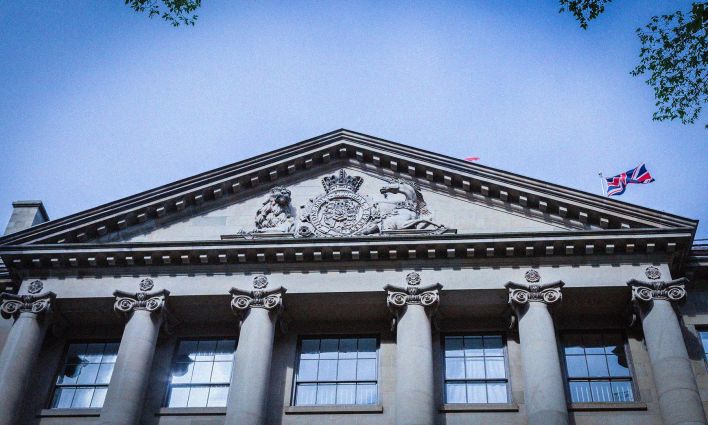Many Government of Canada policies affect provincial governments, directly or indirectly. One of the most important areas is taxation – the life-blood of the body politic. How has this issue been discussed in this federal election?
Living within whose means?
We are constantly told that governments must “live within our means.” But our means are our collective incomes, normally measured as GDP (total output), or as GDP per capita to account for the rising population and its effect on both production and needs. Social programs are slashed because “we can no longer afford them.” Why not?
Social programs expanded considerably in the 1950s and 1960s, a period when incomes per capita (our means) almost doubled – we had twice the means in the 1970s, when social programs first came under attack. Economic growth slowed between 1971 and the early 1990s, when Brian Mulroney was savaging social programs – to about 50 percent over the period, i.e., when our collective “means” were almost three times what they were in the early ‘50s. As a society, we were, collectively, far richer than during the period of the rapid growth in social programs.
One way to make sense of the “can’t afford” claim is that government’s “means” have gone down. Of course, the means of governments are tax revenues. We have a weaker tax base because of tax “reforms” in the ‘70s and ‘80s – such as getting rid of estate taxes on the wealthy, eliminating the top two income tax brackets (on the wealthy), increasing the number of tax deductions – some would say loopholes – (for the wealthy), and slashing corporate taxes (owned primarily by…). Since then opportunities for tax avoidance have been expanded or added. While past governments have claimed that all Canadians benefit from these opportunities, they are primarily used by the top 25 % of tax filers who can take advantage of reductions to capital gains taxes, RRSPs, TFSAs, income splitting, RESPs, etc.
Thus, the logical conclusion is that living within our means requires not belt tightening “for everyone”, but a return to a more progressive tax system, shifting taxes back to those most able (but apparently least willing) to pay. This would, of course, require high income Canadians to have tax rates similar to what they were back in the 1960s, the golden age of economic growth.
Progressive tax reform
Many of the reforms required at the federal level would also improve the progressivity and revenue stream of the provincial income tax without any provincial action.
We could easily switch from granting tax deductions from total income (that favour the wealthy) to using tax credits against taxes owed. When we calculate our tax credits for items such as CPP contributions, the tax credits are the same for all taxpayers and are usually at the minimum tax bracket rate.
Under our current system, tax credits do favour of the high income taxpayers. People with low incomes often cannot afford the particular expense for which the credit is available, such as sport and recreational expenses for children. In addition, these tax credits are “non-refundable” – if you scrimped to send your children to a soccer program you may not make enough income to owe the taxes against which the tax credit can be applied. Tax credits may be of no value to you unless they are refundable, i.e., considered to be equivalent to a tax payment.
The federal tax deductions and special exemptions, e.g., for capital gains, should be eliminated. Some could be personal tax credits and be refundable. Others, meant to encourage education or sports or cultural or other activities deemed important for health or enrichment, should be cancelled and the increased tax revenues generated be used for programs which provide access for all, not just those able to afford them.
In addition, the federal government should revive the estate tax, taxing wealth when passed from one generation to the next, which was dropped in 1973. They should also make tax avoidance through tax havens more difficult (and the penalties higher) and provide more resources to the Canada Revenue Agency to pursue those who avoid paying their fair share of the taxes that finance the services we all use.
The tax system can be made more progressive by reducing our reliance on regressive property and sales taxes. Unlike many European countries, Canadian municipalities rely on property taxes for the bulk of their revenues. Most municipalities struggle to meet their basic responsibilities, especially in rural areas. It would be much more efficient to switch to a municipal tax surcharge on federal income taxes, to be transferred directly to municipalities to allow them to meet their responsibilities better while moving away from property taxes.
With a more progressive federal tax system, the provinces would have a larger tax base with existing provincial tax rates, generating greater revenues. For Nova Scotia, it would mean tens of millions in additional revenues - fully taxing capital gains would bring an additional $50 million.
Party Platforms and Promises on Taxation
<li><strong>Conservatives </strong>have cut large corporation tax rates from 22% to 15% since 2006, costing an estimated $13 billion/year. They also cut the HST by 2 points and have reduced personal taxes by “boutique” tax credits. As a result, their <a href="https://www.policyalternatives.ca/publications/reports/harper-record-2008-2015">legacy</a> includes much larger deficits than they would have otherwise had and they have slashed government services including environmental regulation, boosting Old Age Security eligibility from 65 to 67 and cutting the rate of increase in health transfers by about 50%. They promise still more tax cuts that will help high income families much more than the rest of us: family income splitting (cost $2 billion); increased annual contribution limit for tax-free savings accounts (TFSAs) to $10,000 from $5,500. They enhanced the Universal Child Care Benefit while cutting child tax benefit) and promised a permanent home renovation tax credit up to $5,000/yr. (delayed till we “can afford it”).</li>
<li>The<strong> NDP </strong>promises to fund a $15/day national child care program, and honour UCCB increases, take steps toward a national pharmacare program and poverty reduction measures for seniors by eliminating the CEO stock options’ loophole, reducing tax avoidance (tax haven crackdown and reverse TFSA); and increasing corporate tax rates (15% to 17% to raise $3.7 billion/year). They will also reverse the Conservative’s family income splitting which reduces personal taxes most for high income families ($2 billion).</li>
<li><strong>Liberals </strong>promise to create a new tax bracket of 33 per cent for annual incomes of more than $200,000 and cut middle-class income-tax bracket to 20.5 per cent from current 22 per cent – thus the tax increase won’t fund increased public services. Liberals promise increased infrastructure spending by increased borrowing instead of increased taxation. They will also reverse the Conservative’s family income splitting and increase in the TFSA amount, as the NDP would. They promise a tax free child benefit for families earning up to $150,000 to replace the UCCB.</li>
<li>The <strong>Greens </strong>promise to eliminate personal taxes on incomes below low-income cut-off of $20,000; raise corporate taxes over four years from the current level of 15 per cent to 19 per cent; work with provinces to increase taxes on tobacco and alcohol and introduce a carbon tax.</li>
All 4 parties promise to reduce small business tax rate from 11% to 9% of profits. Liberals and the NDP promise to prevent high income individuals using this low business rate to avoid taxes by incorporating as small businesses. The Liberals and NDP both challenge the taboo against raising taxes. Modestly. A long overdue change.
So, which federal parties are advocating significant tax reform in this election?
The short answer is none is advocating for all of them. The NDP and the Liberals promise modest steps toward progressivity. When weighing the party platforms remember that tax cuts are likely to lead to cuts in government services. Tax increases make improved government services possible. It is important to assess the progressivity of their entire platforms (see this blog).
The bottom line: For fair taxes across Canada and to avoid inter-provincial tax competition, more revenue needs to be raised by the Federal government to meet Federal responsibilities, but also to restore transfers to the provinces. Programs that are provincial responsibilities, such as health, income assistance, and education are major parts of provincial budgets and crucial INVESTMENTS in people. The Federal government has a responsibility to ensure that the same quality of service is available across the country. That is good for Canada.
Michael Bradfield is a retired Dalhousie University Economics professor and Research Associate of CCPA-NS. Brian Gifford is retired and volunteers with Ecology Action Centre, the Affordable Energy Coalition and Nova Scotians for Tax Fairness.





